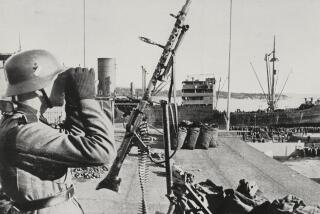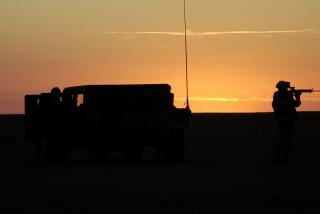Opinion: D-Day plus one: ‘Do not overstate our chances’
Our national recollection of the storming of the Normandy beaches by Allied troops on June 6, 1944, is one of pride, thanks and a sense of inevitability, because we know now that the invasion was the beginning of the end for the Nazi forces. But as the battle was unfolding, victory was not assured. It was hoped for. Prayed for. Planned for. But not guaranteed.
On Friday I posted the Los Angeles Times editorial from D-day itself, which as I noted was thin on details: the nature of editorializing on significant breaking news before the details are known. By June 7, much more was known: that the Allies had successfully established themselves and were continuing to pour a million soldiers into the region, as the Russians pressed Germany from the east and more Allied forces were moving northward through Italy.
But victory was still not assured. Below is The Times’ editorial from the day after D-day, an article that is part analysis and part exhortation — but also part warning: “It is highly important that we do not overstate our chances.”
Indeed. But the military strategy proved out. By early May 1945, 11 months later, Berlin had fallen and Hitler was dead.
Los Angeles Times
June 7, 1944
How Goes the Allied Invasion?
In the greatest military undertaking for the greatest stakes in history there are necessarily multitudinous details tending to confuse the nonmilitary mind. Even with the help of selective headlines and expert day-to-day summaries, it will sometimes be difficult for the lay follower of the European invasion to distinguish between actions which, however spectacular, are only incidental and contributory and those which form vital parts of the major Allied program.
So, at the outset, it may be worthwhile to attempt a broad, general outline of the probable invasion pattern as a whole, fitting together as well as we can the big pieces and leaving the smaller ones to be disposed in the mosaic as developing circumstances may indicate.
The known big pieces are, of course, the western invasion which has just started, the eastern (Russian) invasion which apparently is just about to start and the Reich-ward smash upward through Italy which has now achieved its first great objective with the occupation of Rome. Collateral to these and of equal importance are the strength and continuing support available for each and the counter-strength which the Germans can bring to bear for their opposing.
It is possible, even probable, that there will be Allied assaults at other points on the perimeter of “gefangenes Europa.” [Note: imprisoned Europe] Messrs. Roosevelt and Churchill both have intimated as much, perhaps for the further befuddlement of the enemy. Some of these undoubtedly will be merely diversionary feints, of which there have been several unpublicized ones already; others may be the real thing. Being unable, in their initial stages, to tell one from the other, Jerry must be prepared at all points. He must guard all his doors, however thin he has to spread himself to do so. For the present, however, we may consider only those which attack is thrusting open.
In our three big pieces, a synchronization of effort is already apparent. On June 2, last Friday, occurred the first Allied shuttle-bombing, utilizing Russian bases, of enemy objectives in the probable route of Soviet invasion. On June 4, Sunday, the Allied armies swept into and past Rome, giving the German high command its choice between diverting still more strength from otherwhere to bolster Kesserling’s shattered armies and a potentially dangerous withdrawal northward. On June 6, yesterday, the Western Allies struck with tremendous force at and over the Nazis’ Atlantic Wall on the French coast. This is the invasion-in-chief for which preparations have been under way ever since Dunkerque, four years less two days ago.
The timing of this attack was happy, the preparations for it superb. It appears to have been a complete surprise to the enemy. After many weeks of declaring that invasion could be expected at almost any moment, the Berlin radio announced 48 hours before it occurred that “invasion is nowhere near.” Within the past three weeks the same official Nazi source has announced preparations to stand off assault in Norway, on the French Riviera, in the Balkans and even, by implication, in Spain — pretty much everywhere, in fact, except where it took place.
With the long-imprisoned Allied catamount — or one of them — finally out of the bag, the next moves are obvious. For us, they are to broaden and strengthen our 100-mile string of beachheads and interior paratroop footholds as much as possible before the enemy can assemble the strength to counterattack in force. To seize as many airfields and strategic points as possible, both for our use and to deprive the enemy of them. To shatter, by massed air attacks, the enemy’s military concentrations and further to demoralize his air and ground transportation and supply lines. To get as many as may be of our estimated 1,000,000-man invading force across and entrenched, together with its tanks, mechanized artillery and other equipment and supplies.
For the Germans, they are to try not only to prevent all this but to get together an even greater force to drive us back into the sea — as they have often boasted they could do, and would. Maybe even to attempt a counter-invasion of England. Britain is ready for that, too.
It is highly important that we do not overstate our chances. Much of our early successes have been due to the surprise factor. We dare not assume that, because our losses have been light and our gains considerable in the first 24 hours of invasion, we shall have any pushover. The fact that the Luftwaffe has been so far conspicuously absent, over the Channel, over the beach heads and against our troop-carrying air trains inland, does not mean that there is not plenty of tough sky-fighting ahead. The most we can hope for now is time in which to establish ourselves on bases from which to drive ahead when we have the forces across with which to do it. Moving a million men and their equipment by water is a terrific job, even with the “4000 ships and several thousand smaller craft” of which Mr. Churchill speaks — possibly in part for the misinformation of the enemy.
The counterattack is coming, and it will be with all Hitler has to hit with. He says it will be another Dieppe, the small-scale “invasion” of Aug. 19, 1942, from which the Allied commando forces were virtually thrown back into the sea with heavy losses.
Maybe so; maybe not. At any rate, this is no Dieppe, and the Germans are far less able to put up a proportionate resistance to one than they were two years ago. Their whole strength in all of France and the Low Countries was estimated by competent military experts in Europe a month ago at 50 cut-down divisions — possibly 500,000 to 600,000 men. They have five divisions in Denmark and 12 in Norway, with little,, if any, armor. They have — or had — about 2,000,000 on the Russian front, 250,000 in the Balkans and perhaps 170,000 left in Italy.
To move any considerable part of any of the five last-named forces, with the possible exception of that in Denmark, into France would be to leave dangerous loopholes for other Allied attacks. Large troop movements to the present invasion area, even from central France or from whatever reserve there may be in Germany, would be hampered by shot-to-pieces road and rail transportation facilities and by the Allies superiority in the air.
Somehow, however, the ingenious and desperate enemy will manage to get together a formidable resistance. Like the rabbit that climbed a tree to escape the pursuing dog, he has to.
For our part, we may rest our chief confidence on the fact that topflight military experts have reduced to an irreducible minimum the chances of Allied failure in this great adventure. As Secretary Stimson remarked last May 25:
“The invasion is too well planned to fail.”
More to Read
A cure for the common opinion
Get thought-provoking perspectives with our weekly newsletter.
You may occasionally receive promotional content from the Los Angeles Times.







